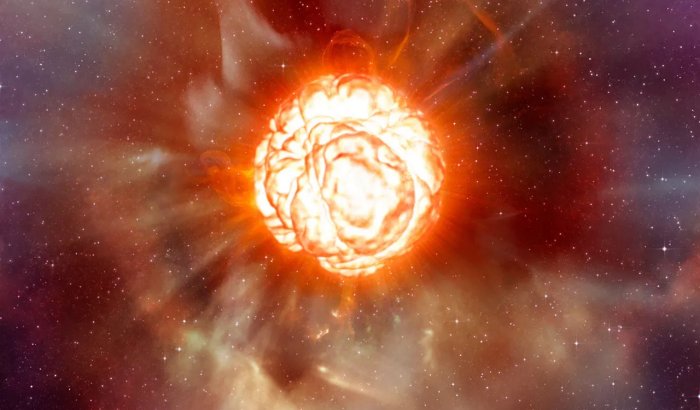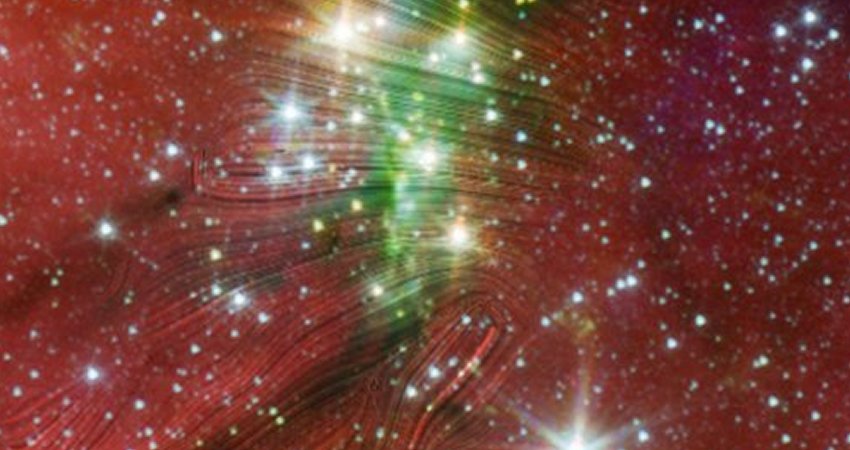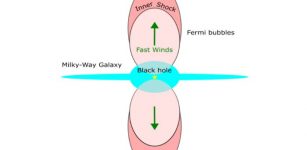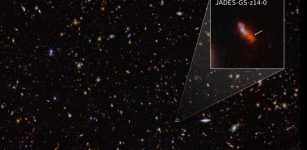Pulsating Supergiant Betelgeuse That Might Go Supernova
Eddie Gonzales Jr. – MessageToEagle.com – The red supergiant – Betelgeuse – is nearing the end of its life, and when a star over 10 times the mass of the Sun dies, it goes out in spectacular fashion.
Betelgeuse (also known as Alpha Orionis) is a red supergiant star about 600 light-years from the Sun.
 An artist’s impression of Betelgeuse and the plume of gas around it. ESO/L. Calçada
An artist’s impression of Betelgeuse and the plume of gas around it. ESO/L. Calçada
Betelgeuse is cooler than the Sun, but it is more massive and over 1000 times larger. If placed at the center of our Solar System, it would extend past the orbit of Jupiter.
It is one of the brightest stars in the familiar constellation of Orion, the Hunter.
With its brightness recently dipping to the lowest point in the last hundred years, many space enthusiasts are excited that Betelgeuse may soon go supernova, exploding in a dazzling display that could be visible even in daylight.
While the famous star in Orion’s shoulder will likely meet its demise within the next million years—practically a couple days in cosmic time—scientists maintain that its dimming is due to the star pulsating.
UC Santa Barbara researchers have already made predictions about the brightness of the supernova that would result when a pulsating star like Betelgeuse explodes.
“We wanted to know what it looks like if a pulsating star explodes at different phases of pulsation,” said Jared Goldberg, a National Science Foundation graduate research fellow, who along with other researchers published a paper.
“Earlier models are simpler because they don’t include the time-dependent effects of pulsations.”
When a star the size of Betelgeuse finally runs out of material to fuse in its center, it loses the outward pressure that kept it from collapsing under its own immense weight. The resultant core-collapse happens in half a second, far faster than it takes the star’s surface and puffy outer layers to notice.
As the iron core collapses the atoms disassociate into electrons and protons. These combine to form neutrons, and in the process release, high-energy particles called neutrinos. Normally, neutrinos barely interact with other matter—100 trillion of them pass through your body every second without a single collision. That said, supernovae are among the most powerful phenomena in the universe. The numbers and energies of the neutrinos produced in the core-collapse are so immense that even though only a tiny fraction collides with the stellar material, it’s generally more than enough to launch a shockwave capable of exploding the star.
That resulting explosion smacks into the star’s outer layers with stupefying energy, creating a burst that can briefly outshine an entire galaxy. The explosion remains bright for around 100 days since the radiation can escape only once ionized hydrogen recombines with lost electrons to become neutral again. This proceeds from the outside in, meaning that astronomers see deeper into the supernova as time goes on until finally, the light from the center can escape. At that point, all that’s left is the dim glow of radioactive fallout, which can continue to shine for years.
A supernova’s characteristics vary with the star’s mass, total explosion energy and, importantly, its radius. This means Betelgeuse’s pulsation makes predicting how it will explode rather more complicated.
The researchers found that if the entire star is pulsating in unison—breathing in and out if you will—the supernova will behave as though Betelgeuse was a static star with a given radius. For the simple pulsation case, the team’s model yielded similar results to the models that didn’t account for pulsation.
“It just looks like a supernova from a bigger star or a smaller star at different points in the pulsation,” Goldberg explained. “It’s when you start considering pulsations that are more complicated, where there’s stuff moving in at the same time as stuff moving out—then our model actually does produce noticeable differences,” he said.
In these cases, the researchers discovered that as light leaks out from progressively deeper layers of the explosion, the emissions would appear as though they were the result of supernovae from different sized stars.
“Light from the part of the star that is compressed is fainter,” Goldberg explained, “just as we would expect from a more compact, non-pulsating star.” Meanwhile, light from parts of the star that were expanding at the time would appear brighter, as though it came from a larger, non-pulsating star.
Written by Eddie Gonzales Jr. – MessageToEagle.com Staff










